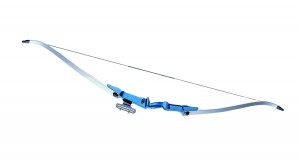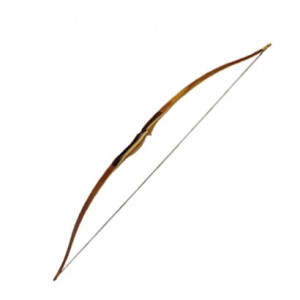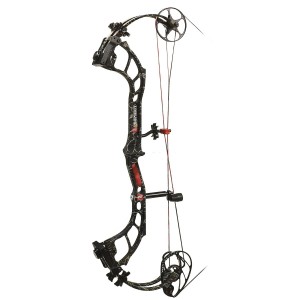The Bow
There are 3 main types of bows used in archery:
Recurve: This is the only bow style allowed at the Olympics. Mainly associated with target archery, and ideal as a starter bow, recurve is the most popular style of archery in the UK.
Compound: Compound bows are the newest type of bow, and almost anything is allowed as long as it is not electronic. These bows consist of cams to make drawing the bow easier and giving a much larger weight. Accessories include telescopic sights and release aids.
Traditional: Archery in its simplest form, traditional bow include English Longbows, American Flatbows and Japanese Kyudo Bows. Wooden arrows with feathers are usually used. Other accessories include quivers and gloves.
 Arrows: Arrows can be made from wood, aluminium, glass fibre, carbon fibre or a combination of aluminium and carbon fibre. The fletchings or vanes on the arrows can be made from either feathers or a variety of modern plastic materials.
Arrows: Arrows can be made from wood, aluminium, glass fibre, carbon fibre or a combination of aluminium and carbon fibre. The fletchings or vanes on the arrows can be made from either feathers or a variety of modern plastic materials.
Stabilisers
Sights
Finger tabs
Release aids
Arm Bracers
Quivers
The main types of bow that are used in archery are recurve, compound and longbow, there ARE other types of bow but for the sake of keeping this page simple I have only mentioned the 3 main types.
RECURVE: recurve is a bow with 4 main parts, the riser, limbs, and sting. The riser is the part of the bow that you hold onto and it contains mounts for the sights, limbs and sight. The limbs are the parts of the bow that store the energy of pulling the string back before you release, there are two that attach to the top and the bottom of the riser and the string is the part which you pull back, it is attached between the tips of the limbs. This type of bow is fairly basic, and is a good bow to start archery with as it is not too complicated, it is easily fired and is reliable.
COMPOUND: a compound bow is much more different from a recurve bow, as in most cases it cannot be taken down for storage, so it stays as one unit, a compound bow may also be easier to fire than a recurve bow as when the string is pulled back past a point, the force is taken in by the cams at the tips of each limb, making this type of bow good for hunting, as you can keep it held back for as long as you like before release, compound bows are usually used with release aids, a trigger which is clipped onto the string and when you need to fire the bow, you click a button or pull a trigger and the string will release. the compound bow is made up of two limbs with cams at the tips, a riser and a string, the string is much more different from a recurve as well because it is wound round the cams, making it longer.
LONGBOW: the longbow is one of the first types of bows to become popular, and it is still used today! longbows are only made up of two pieces, the string and the bow itself. longbows can also be considered the most difficult bows to aim and fire, because you are only dependant on a rubber band for aiming, shooting a longbow is also similar to shooting a recurve bow barebow, which is explained more in the next step!
Types of arrows and fletchings
The most common form of arrow consists of a shaft with an arrowhead attached to the front end and with fletchings and a nock attached to the other end. Arrows across time and history are normally carried in a container known as a quiver, which can take many different forms. Shafts of arrows are typically composed of solid wood, bamboo fiberglass, aluminium alloy, carbon fiber, or composite materials. Wooden arrows are prone to warping. Fiberglass arrows are brittle, but can be produced to uniform specifications easily. Aluminium shafts were a very popular high-performance choice in the latter half of the 20th century due to their straightness, lighter weight, and subsequently higher speed and flatter trajectories. Carbon fiber arrows became popular in the 1990s and are very light, flying even faster and flatter than aluminium arrows. Today, arrows made up of composite materials are the most popular tournament arrows at Olympic Events, especially the Easton X10 and A/C/E.
The arrowhead is the primary functional component of the arrow. Some arrows may simply use a sharpened tip of the solid shaft, but it is far more common for separate arrowheads to be made, usually from metal, stone, or other hard materials. The most commonly used forms are target points, field points, and broadheads, although there are also other types, such as bodkin, judo, and blunt heads.
Shield cut straight fletching – here the hen feathers are barred red
Fletching is traditionally made from bird feathers. Also solid plastic vanes and thin sheetlike spin vanes are used. They are attached near the nock (rear) end of the arrow with thin double sided tape, glue, or, traditionally, sinew. Three fletches is the most common configuration in all cultures, though as many as six have been used. Two will result in unstable arrow flight. When three-fletched the fletches are equally spaced around the shaft with one placed such that it is perpendicular to the bow when nocked on the string (though with modern equipment, variations are seen especially when using the modern spin vanes). This fletch is called the “index fletch” or “cock feather” (also known as “the odd vane out” or “the nocking vane”) and the others are sometimes called the “hen feathers”. Commonly, the cock feather is of a different color. However, if archers are using fletching made of feather or similar material, they may use same color vanes, as different dyes can give varying stiffness to vanes, resulting in less precision. When four-fletched, often two opposing fletches are cock feathers and occasionally the fletches are not evenly spaced.
Protective equipment
Main articles: Bracer, Finger tab and Thumb ring
A right-hand finger tab to protect the hand while the string is drawn.
Most archers wear a bracer (also known as an arm-guard) to protect the inside of the bow arm from being hit by the string and prevent clothing from catching the bow string.
The drawing fingers are normally protected by a leather tab, glove, or thumb ring. A simple tab of leather is commonly used, as is a skeleton glove.
Release aids
A release aid is a mechanical device designed to give a crisp and precise loose of arrows from a compound bow. In the most commonly used, the string is released by a finger-operated trigger mechanism, held in the archer’s hand or attached to their wrist. In another type, known as a back-tension release, the string is automatically released when drawn to a pre-determined tension.
Stabilisers
Stabilisers are mounted usually on the front of the bow below the handle and on the right side, below the handle to help aiming by keeping the bow steady.

